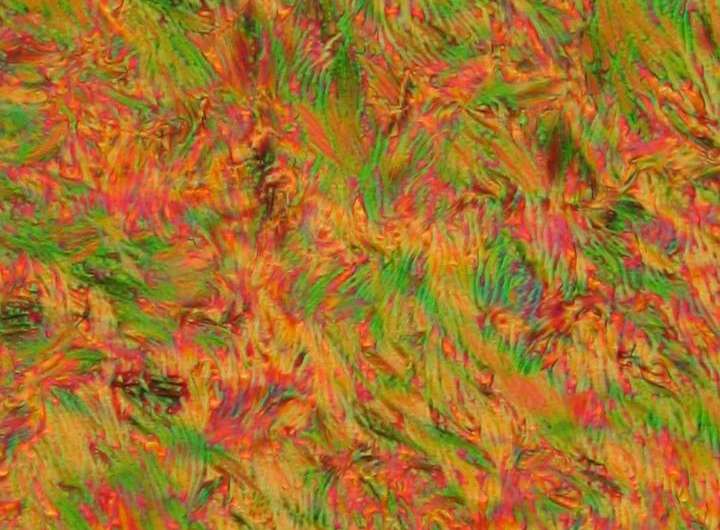Scientists have synthesized new liquid-crystalline photochrom

Chemists at the Lomonosov Moscow State University, in collaboration with Czech partners, have synthesized and studied new liquid-crystal photochromic polymers. These polymers combine optical properties of liquid crystals with mechanical properties of polymers. They quickly change molecular orientation under the influence of external fields and form coatings, films and details of complex shape. An important advantage of such systems in comparison with low-molecular-mass liquid crystals is that at room temperature, liquid-crystal polymers exist in a glass-like state, with fixed molecular orientation.
Liquid-crystal polymers comprise molecules with high molecular mass, called macromolecules. They are comb-shaped, which implies that photosensitive rigid azobenzene fragments (C6H5N=NC6H5) are attached to the main flexible polymer chain with the help of spacers, consisting of CH2 moieties. These fragments are striving for sequencing and could form a wide variety of "packings"—namely, liquid-crystal phases. When light strikes such polymers, azobenzene groups isomerize, which results in alteration of polymers' optical properties. Such polymers are called photochromic.
The scientists have paid special attention to the processes of photoisomerization and photo-orientation. Photoisomerization is rearrangement of bonds inside a polymer molecule under the influence of light. In this study, photo-orientation is the alteration of rod-like azobenzene fragments' orientation with plane polarized light, the direction of which determines the electric field. When exposed to polarized light, azobenzene fragments change their angle in the course of photoisomerization cycles. This occurs until their orientation becomes perpendicular to the polarization plane of the incident light and the fragments are no longer capable of absorbing light. The photo-orientation process not only allows researchers to change the orientation of azobenzene fragments of macromolecules, but also causes dichroism and birefringence. Dichroism is the intensity difference of polarized light absorption in orthogonal directions. Birefringence refers to a light beam splitting into two components with orthogonal (perpendicular) polarization; the direction of one of these components doesn't change, while the second beam is refracted.
Alexey Bobrovsky, one of the article authors, says, "The key idea of our project is to study how the chemical structure of new comb-shaped liquid-crystal photochromic polymers influences their phase behavior and photooptical properties. Photoisomerization and photo-orientation processes allow us to control the phase behavior and optical properties of the elaborated systems."
According to the authors, the most significant task was to study photo-optical properties and photochromism of the obtained polymers. This stage was divided into two parts: irradiation of the polymer films by unpolarized UV light, during which photoisomerization (namely, rearrangement of intermolecular communications) took place. And the second part involved irradiation by polarized light resulting in photo-orientation.
Alexey Bobrovsky observes that the article relates to a major cycle of projects devoted to photoinduced processes in photochromic liquid-crystal polymers. The scientist says, "Photoisomerization and photo-orientation have applications for so-called smart materials. They react to any external stimuli and could be used for information recording, storage and transfer, as well as in optical devices of diverse complexity. These precise polymers are not practical in a real-life scenario, as they are too expensive and their synthesis is quite complicated. On the other hand, you can't always predict what systems have applications in the future."
More information: Alexey Bobrovsky et al, Photo-Orientation Phenomena in Photochromic Liquid Crystalline Azobenzene-Containing Polymethacrylates with Different Spacer Length, Macromolecular Chemistry and Physics (2017). DOI: 10.1002/macp.201700127
Provided by Lomonosov Moscow State University




















